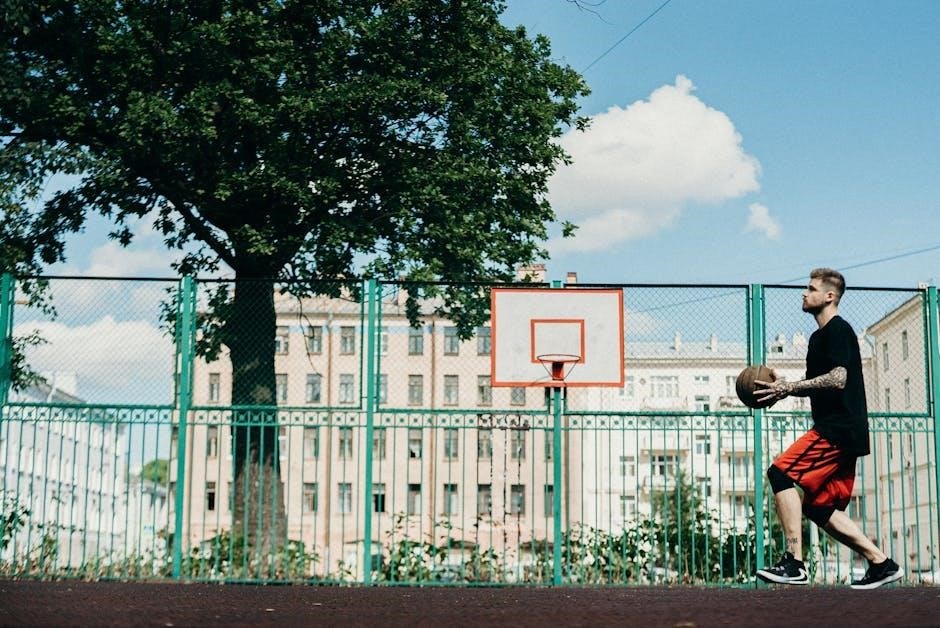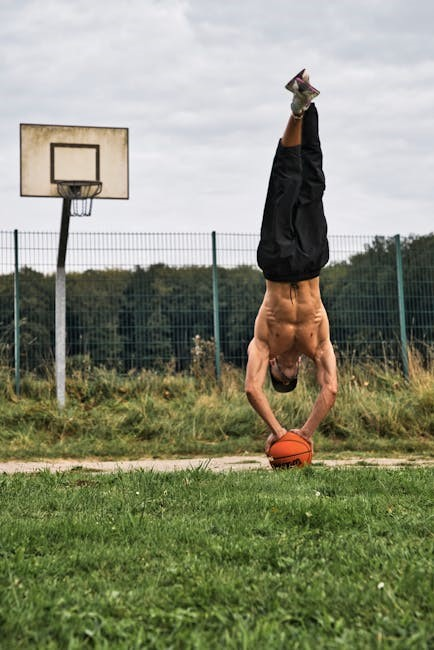A basketball workout plan PDF is a structured guide designed to enhance performance, offering drills for skill development, strength, and conditioning․ It ensures consistency and progression․
1․1 What is a Basketball Workout Plan PDF?
A Basketball Workout Plan PDF is a comprehensive guide designed to help players improve their skills and physical abilities through structured exercises․ It typically includes drills for skill development, strength training, conditioning, and flexibility, tailored to enhance performance on the court․ The PDF format allows for easy access and organization, making it a convenient resource for players and coaches․ These plans often cover both in-season and off-season training, providing detailed routines and schedules to ensure consistency and progress․ By focusing on specific basketball-related skills like shooting, dribbling, and agility, the plan helps athletes build endurance, power, and overall athleticism․ It’s an essential tool for anyone aiming to elevate their basketball game effectively․
1․2 Importance of Structured Workout Plans for Basketball Players
A structured workout plan is essential for basketball players to ensure consistent progress, prevent injuries, and maximize performance․ It provides a clear roadmap for improving specific skills, such as shooting, dribbling, and agility, while also enhancing strength, endurance, and overall athleticism․ A well-designed plan helps players stay focused and motivated, ensuring they target areas needing improvement․ It also allows for proper recovery and avoids overtraining, which is crucial for long-term success․ By following a structured plan, players can track their progress effectively, making adjustments as needed to achieve their goals․ This organized approach fosters discipline and accountability, which are key to reaching peak performance levels in basketball․

Components of a Basketball Workout Plan
A basketball workout plan includes skill development, strength training, conditioning, and flexibility exercises․ These components work together to improve performance, build endurance, and reduce injury risks․
2․1 Skill Development Exercises
Skill development exercises in a basketball workout plan focus on improving specific basketball skills such as dribbling, shooting, and ball handling․ These exercises are designed to enhance a player’s overall game performance․ Players often practice drills like figure-eight dribbling, crossovers, and behind-the-back dribbles to improve ball control․ Shooting drills, including catch-and-shoot, off-the-dribble, and spot-up shots, are essential for developing accuracy․ Players also work on passing accuracy and court vision․ Additionally, agility drills like cone exercises and ladder drills help improve footwork and speed․ These exercises are tailored to address individual weaknesses and build confidence on the court․ Consistency in practicing these skills is key to achieving long-term improvement․ Over time, these exercises translate into better performance during games․
2․2 Strength Training for Basketball
Strength training is a critical component of a basketball workout plan, focusing on building power, speed, and endurance․ Players engage in exercises like squats, lunges, and deadlifts to strengthen the lower body, essential for explosive jumps and quick movements․ Upper body workouts, such as bench presses and pull-ups, enhance shooting and rebounding power․ Core exercises like planks and Russian twists improve stability and balance․ Plyometric drills, including box jumps and burpees, develop fast-twitch muscles for rapid bursts of energy․ Strength training also helps prevent injuries by fortifying muscles and joints․ A well-structured program ensures players can meet the physical demands of the game while maintaining peak performance throughout the season․
2․3 Conditioning and Endurance Drills
Conditioning and endurance drills are essential for basketball players to maintain stamina throughout games․ These exercises focus on improving cardiovascular health, speed, and agility․ High-intensity interval training (HIIT) is commonly used, involving short bursts of intense activity followed by brief recoveries․ suicides, and shuttle runs are popular for enhancing speed and endurance․ Players also engage in prolonged sprints to simulate game scenarios, building the ability to perform at high intensity over time․ Endurance training ensures players can sustain effort during the 36-day off-season program and beyond, making it a cornerstone of any successful basketball workout plan․ Proper conditioning also reduces fatigue, allowing for consistent performance in critical moments of the game․
2․4 Flexibility and Mobility Routines
Flexibility and mobility routines are crucial for basketball players to maintain range of motion, prevent injuries, and enhance performance․ These exercises focus on improving joint mobility, muscle elasticity, and overall movement efficiency․ Dynamic stretching, yoga, and foam rolling are common practices to increase flexibility․ Incorporating these routines into daily workouts ensures players can perform complex movements with ease․ Mobility drills, such as leg swings and hip circles, target key areas used in basketball, like the hips and knees․ Consistent flexibility training also aids in recovery, reducing muscle stiffness after intense workouts․ By prioritizing mobility, players can maintain optimal physical condition and longevity in their basketball careers․ These routines are often overlooked but are vital for peak performance and injury prevention․

Creating a Structured Basketball Workout Plan
Creating a structured basketball workout plan involves setting clear goals, planning daily and weekly sessions, and tracking progress․ It balances skill development, strength, and conditioning for optimal performance․
3․1 Setting Goals and Objectives

Setting clear and achievable goals is essential for any successful basketball workout plan․ Start by defining both short-term and long-term objectives, such as improving shooting accuracy or increasing speed․ Specific, measurable, and time-bound goals help maintain focus and motivation․ For example, aiming to make 50 free throws daily or sprinting faster in drills․ Visualizing success and maintaining a positive mindset are crucial․ Consistency in mechanics, like keeping shooting techniques unchanged, ensures steady progress․ Pushing past comfort zones fosters skill development, while categorizing abilities as “strong enough” or “fast enough” prevents wasted effort․ This structured approach ensures workouts are purposeful and effective․
3․2 Planning Workouts by Day and Week
Planning workouts by day and week is crucial for a balanced and effective basketball training program․ Start by allocating specific days for skill development, strength training, and conditioning․ For example, dedicate two days to skill-focused drills like shooting and ball handling, while reserving others for strength and endurance․ Ensure no high-intensity workouts occur on consecutive days to allow recovery․ Weekly plans should mix high and low-intensity sessions, with at least one rest day․ Consistency is key, but flexibility is also important to avoid burnout․ Organize drills to match your goals, such as focusing on post moves or perimeter play․ A well-structured weekly schedule maximizes progress and prevents overtraining, ensuring optimal performance on the court․
3․3 Tracking Progress and Adjustments
Tracking progress is essential to ensure the effectiveness of a basketball workout plan․ Regularly monitor improvements in shooting accuracy, speed, strength, and endurance․ Use a workout log to record stats like free throws made, sprint times, or weight lifted․ Compare these metrics weekly to gauge progress․ Adjustments should be made based on performance plateaus or areas needing improvement․ For instance, if shooting accuracy isn’t increasing, incorporate more focused drills․ Stay flexible and tweak the plan as needed to avoid overtraining․ Celebrate small victories to maintain motivation and adjust goals accordingly․ Consistency and adaptability are key to achieving long-term success in basketball training․

Periodization in Basketball Training
Periodization divides training into phases, focusing on specific goals like strength or endurance․ It ensures peak performance during the season while preventing overtraining and injury risks․
4․1 In-Season Training Focus
In-season training focuses on maintaining and refining skills, with reduced intensity to avoid overtraining․ The goal is to preserve peak performance while addressing specific game demands․ Workouts emphasize sport-specific drills, such as agility exercises and game situation simulations․ Strength training is scaled back but remains crucial for injury prevention and stability․ Conditioning sessions are tailored to improve endurance and explosiveness, ensuring players can sustain high levels of effort throughout games․ Recovery techniques, like active rest and mobility routines, are prioritized to prevent fatigue․ Coaches also incorporate video analysis to refine strategies and address weaknesses․ The balance between practice and recovery ensures players stay fresh mentally and physically, ready to perform optimally during competitions․
4․2 Off-Season Training Strategies
Off-season training is critical for building foundational strength, speed, and endurance․ It focuses on enhancing athletic performance through targeted workouts․ Players engage in strength training to build muscle and improve power, while conditioning drills boost cardiovascular fitness․ Skill development is emphasized, allowing players to refine techniques without game pressure․ The off-season also provides time for recovery and injury prevention, ensuring players return stronger․ Coaches design structured programs with progressive overload to avoid plateaus․ Nutrition and recovery strategies are tailored to support growth and repair․ This period is essential for long-term development, setting the stage for peak performance during the season․ A well-planned off-season regimen ensures players are physically and mentally prepared for upcoming challenges․

Sample Basketball Workout Plan PDF
A sample basketball workout plan PDF provides a comprehensive, structured routine․ It includes daily drills and weekly schedules, focusing on skill development, strength, and performance enhancement․
5․1 Example of a Daily Workout Routine
A daily basketball workout routine should balance skill development, strength, and conditioning․ Begin with a dynamic warm-up to prepare the body for intense activity․ Focus on form shooting, ball handling, and agility drills․ Incorporate strength training with exercises like squats and lunges to build power․ Add plyometric workouts for explosiveness, such as box jumps and burpees․ Dedicate time to defensive drills, including lateral shuffles and reaction exercises․ Finish with conditioning drills, such as sprints and suicides, to improve endurance․ End the session with stretching to enhance flexibility and aid recovery․ Stay consistent with the routine, gradually increasing intensity to avoid plateaus and prevent injuries․
5․2 Weekly Schedule for Skill Enhancement
A weekly basketball workout schedule should focus on progressive skill development․ Start the week with shooting drills, emphasizing form and consistency․ Dedicate two days to ball handling and agility, incorporating cone drills and figure-eight exercises․ Mid-week, focus on defensive techniques, such as closeouts and help-side rotations․ Include a day for post and perimeter skill work, alternating between low and high post moves․ Incorporate live game scenarios to apply skills under pressure․ Finish the week with a recovery day, focusing on light shooting and flexibility exercises․ Ensure each session builds on the previous one, gradually increasing intensity and complexity to maximize improvement․ Consistency and variety are key to enhancing overall basketball performance․

Nutrition and Recovery for Optimal Performance

A balanced diet rich in proteins, carbs, and healthy fats fuels performance․ Proper hydration and recovery techniques, like stretching and sleep, are essential for injury prevention and growth․
6․1 Diet Recommendations for Basketball Players
Basketball players require a nutrient-dense diet to optimize energy and recovery․ Emphasize lean proteins like chicken and fish for muscle repair, complex carbs such as whole grains and fruits for sustained energy, and healthy fats from nuts and avocados․ Hydration is crucial, with water and electrolyte-rich drinks recommended․ Timing meals around workouts, with a pre-game meal high in carbs and protein, and post-workout refueling within 30-60 minutes, supports performance․ Avoid processed foods and Sugary snacks to maintain peak condition․ A personalized meal plan can address specific needs, ensuring players fuel their bodies effectively for training and competition․
6․2 Recovery Techniques to Prevent Injuries

Recovery is vital for basketball players to prevent injuries and maintain performance․ Techniques include stretching, foam rolling, and ice baths to reduce muscle soreness․ Proper hydration and sleep are also critical for muscle repair․ Incorporating rest days and active recovery, such as light cardio or yoga, helps avoid overtraining․ Additionally, compression garments and massage therapy can improve blood flow and reduce muscle tension․ Ensuring adequate nutrition supports tissue repair․ A well-structured recovery plan enhances durability, allowing players to train consistently and perform at their best while minimizing the risk of injuries․

Final Thoughts on Basketball Workout Plan PDF
Adapting your basketball workout plan PDF as needed ensures continuous improvement․ Recovery and consistency are key to long-term success․ Stay committed and celebrate progress along the way․
7․1 Consistency and Dedication
Consistency and dedication are the cornerstones of any successful basketball workout plan․ Players must commit to regular training, even when progress seems slow․ Sticking to the schedule ensures skill development and physical conditioning over time․ Dedication also involves maintaining proper nutrition and recovery habits, as these factors significantly impact performance․ Without consistency, it’s challenging to build the endurance and strength needed for competitive play․ Coaches and players should emphasize the importance of showing up daily with focus and effort․ Over time, this dedication will translate into measurable improvements on the court, making the hard work worthwhile․ Stay committed, and results will follow;
7․2 Staying Motivated Throughout the Training
Staying motivated is crucial for adhering to a basketball workout plan․ Set clear, achievable goals and celebrate small victories to maintain enthusiasm․ Surround yourself with supportive teammates or coaches who encourage progress․ Remind yourself of your “why” and visualize success to stay driven․ Incorporate variety in drills to avoid monotony and keep workouts engaging․ Track improvements, as seeing results boosts motivation․ Embrace challenges as opportunities to grow, and don’t fear failure—it’s part of the journey․ Stay positive, and reward dedication with recovery days or fun activities․ Motivation fluctuates, but consistent effort leads to long-term success․ Keep pushing forward, and remember, every rep brings you closer to your goals․
